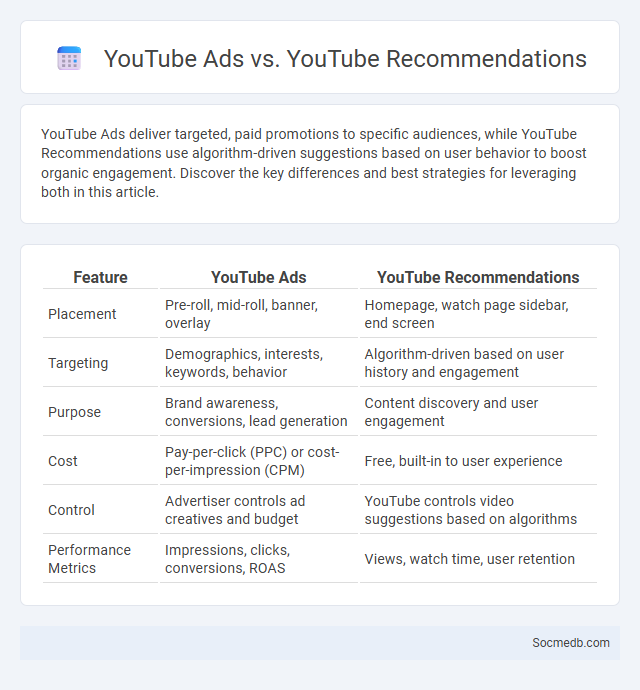
Photo illustration: YouTube Ads vs YouTube Recommendations
YouTube Ads deliver targeted, paid promotions to specific audiences, while YouTube Recommendations use algorithm-driven suggestions based on user behavior to boost organic engagement. Discover the key differences and best strategies for leveraging both in this article.
Table of Comparison
| Feature | YouTube Ads | YouTube Recommendations |
|---|---|---|
| Placement | Pre-roll, mid-roll, banner, overlay | Homepage, watch page sidebar, end screen |
| Targeting | Demographics, interests, keywords, behavior | Algorithm-driven based on user history and engagement |
| Purpose | Brand awareness, conversions, lead generation | Content discovery and user engagement |
| Cost | Pay-per-click (PPC) or cost-per-impression (CPM) | Free, built-in to user experience |
| Control | Advertiser controls ad creatives and budget | YouTube controls video suggestions based on algorithms |
| Performance Metrics | Impressions, clicks, conversions, ROAS | Views, watch time, user retention |
Introduction to YouTube Ads and Recommendations
YouTube Ads offer businesses a powerful platform to reach a global audience through various formats like skippable in-stream ads, non-skippable ads, and bumper ads, maximizing brand visibility and engagement. The platform's sophisticated recommendation algorithm analyzes user behavior, preferences, and watch history to serve personalized video suggestions, increasing viewer retention and ad effectiveness. Leveraging YouTube's targeting options, advertisers can optimize campaigns by demographics, interests, and keywords to drive higher conversion rates.
Understanding YouTube Ads: Types and Features
YouTube Ads encompass various types, including TrueView In-Stream, Discovery Ads, Non-Skippable Ads, Bumper Ads, and Overlay Ads, each designed to target specific audience behaviors and engagement goals. TrueView Ads allow viewers to skip after 5 seconds, offering cost-effective options for advertisers who pay only when viewers watch or interact, enhancing your campaign efficiency. Features like detailed targeting, call-to-action overlays, and analytics empower you to optimize ad performance and maximize reach on the world's second-largest search engine.
How YouTube Recommendations Work
YouTube recommendations rely on complex machine learning algorithms that analyze user behavior, including watch history, search queries, and engagement metrics like likes and comments. The system uses collaborative filtering and deep neural networks to predict videos aligning with user interests and preferences, enhancing personalized content discovery. Continuous data feedback loops allow the platform to refine recommendations in real-time, maximizing viewer retention and satisfaction.
Comparing YouTube Recommendations and General Recommendations
YouTube recommendations utilize advanced machine learning algorithms that analyze your watch history, engagement patterns, and preferences to deliver highly personalized content suggestions. In contrast, general recommendations across social media platforms often rely on broader factors such as trending topics, user demographics, and popular posts to suggest content. Your experience on YouTube is tailored through deep user behavior insights, making its recommendation system more precise and relevant compared to generalized social media suggestions.
The Algorithms Behind YouTube Ads and Recommendations
YouTube's algorithms use complex machine learning models to analyze your viewing history, engagement patterns, and demographic data to deliver personalized ad content and video recommendations. These systems prioritize relevance and user retention by predicting which ads and videos are most likely to capture your attention and encourage interaction. By continuously refining these predictions with real-time feedback, YouTube maximizes both viewer satisfaction and advertiser ROI.
User Engagement: Ads vs Recommendations
User engagement on social media varies significantly between ads and algorithm-driven recommendations, with recommendations typically yielding higher click-through rates and longer session durations. Ads often rely on targeted demographics and behavioral data to increase relevance, but recommendations leverage personalized content based on user interactions, fostering deeper engagement. Platforms like Instagram and TikTok report that personalized recommendations can boost user retention and conversion rates more effectively than traditional ad placements.
Monetization Impact: Ads vs Organic Recommendations
Social media monetization significantly depends on the balance between ads and organic recommendations, as ads generate direct revenue through targeted campaigns while organic content fosters authentic engagement and long-term user retention. Your brand can maximize ROI by strategically leveraging paid advertisements to drive immediate conversions and optimizing organic recommendations to enhance visibility and build trust. Data shows that users are 70% more likely to purchase products discovered via organic recommendations compared to ads, underlining the importance of a hybrid monetization approach.
Audience Targeting: Differences and Strategies
Audience targeting in social media involves identifying specific demographics, interests, and behaviors to deliver personalized content and advertisements. Platforms like Facebook, Instagram, and LinkedIn offer advanced targeting options such as age, location, job title, and online activity to optimize campaign reach and engagement. Effective strategies include segmenting audiences based on data analytics, utilizing lookalike audiences, and continuously refining targeting parameters to improve conversion rates and return on investment.
Pros and Cons: YouTube Ads, YouTube Recommendations, and General Recommendations
YouTube ads offer targeted marketing opportunities with high user engagement, but can disrupt viewer experience and lead to ad fatigue. YouTube recommendations enhance content discovery by leveraging algorithms tailored to user preferences, yet they risk creating echo chambers and promoting misinformation. General social media recommendations boost content visibility and personalization while raising concerns about privacy, data exploitation, and potential bias in algorithmic curation.
Choosing the Right Approach for Your Content Strategy
Selecting the optimal content strategy on social media requires analyzing audience demographics, platform algorithms, and engagement metrics. Tailoring content formats--such as videos, stories, or infographics--according to platform-specific trends maximizes reach and interaction. Consistently evaluating performance data enables agile adjustments, ensuring alignment with evolving user preferences and brand objectives.
 socmedb.com
socmedb.com